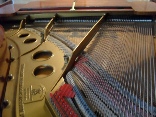

For intervals wider than an octave, you can simply carry on numbering them up from an octave (8th). In this way odd intervals are still either both line or both space notes, and even intervals are a mix of space and line notes. Alternatively, you can use the word “compound” and then reckon the interval from the bottom note as if it were an octave higher.

When fully describing the interval, you think of the major scale of the bottom note just as before and remember that compound 4ths and 5ths (11ths and 12ths) are “perfect” intervals (i.e. cannot be “major” or “minor”).

From “step 1”, this must be an odd interval given it’s written as two line notes. 3 clear lines between the notes means its a 9ths. 9ths are the same as ... (subtract 7) ... 2nds.
Looking at clef, key signature and any accidentals on the bottom note, gives the bottom note as “C”. The 2nd note of the C major scale is D (natural) therefore the major 9th is between the C (natural) and the D(natural) and all the other 9th intervals shown above are reasoned in the same way as before.